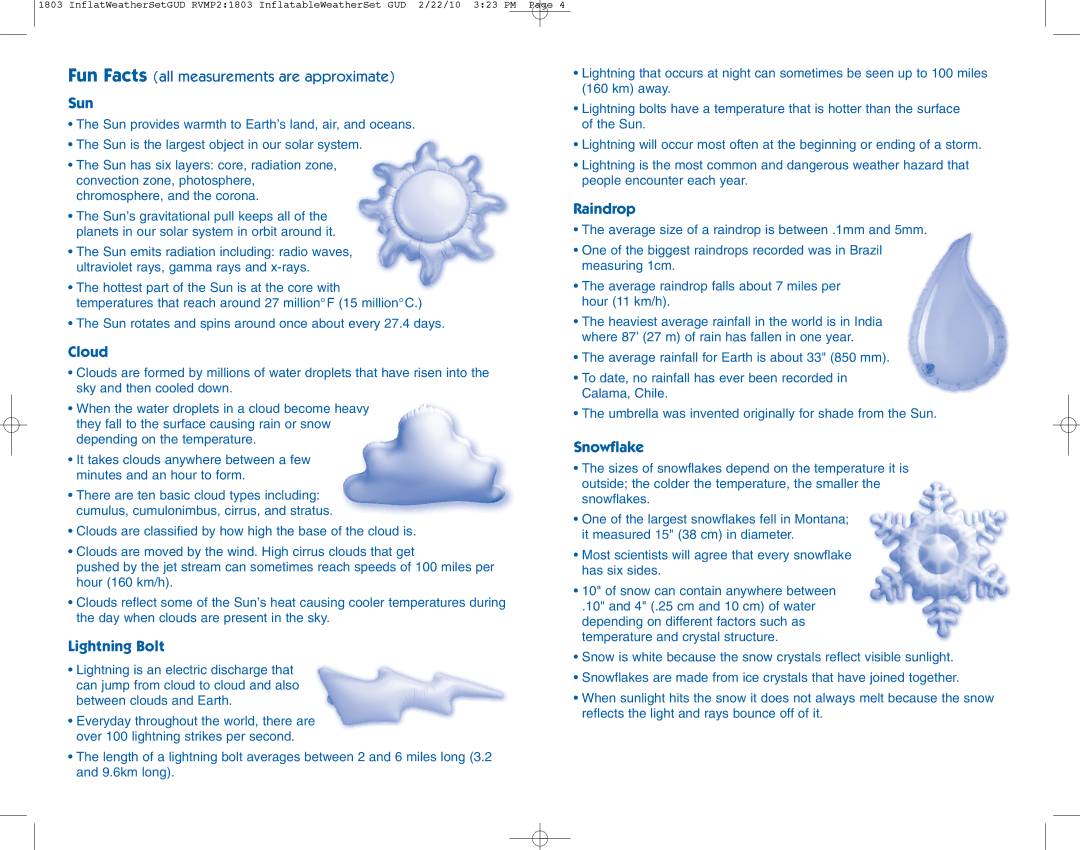
1803 InflatWeatherSetGUD RVMP2:1803 InflatableWeatherSet GUD 2/22/10 3:23 PM Page 4
Fun Facts (all measurements are approximate)
Sun
•The Sun provides warmth to Earth’s land, air, and oceans.
•The Sun is the largest object in our solar system.
•The Sun has six layers: core, radiation zone, convection zone, photosphere, chromosphere, and the corona.
•The Sun’s gravitational pull keeps all of the planets in our solar system in orbit around it.
•The Sun emits radiation including: radio waves, ultraviolet rays, gamma rays and
•The hottest part of the Sun is at the core with temperatures that reach around 27 million°F (15 million°C.)
•The Sun rotates and spins around once about every 27.4 days.
Cloud
•Clouds are formed by millions of water droplets that have risen into the sky and then cooled down.
•When the water droplets in a cloud become heavy they fall to the surface causing rain or snow depending on the temperature.
•It takes clouds anywhere between a few minutes and an hour to form.
•There are ten basic cloud types including: cumulus, cumulonimbus, cirrus, and stratus.
•Clouds are classified by how high the base of the cloud is.
•Clouds are moved by the wind. High cirrus clouds that get
pushed by the jet stream can sometimes reach speeds of 100 miles per hour (160 km/h).
•Clouds reflect some of the Sun’s heat causing cooler temperatures during the day when clouds are present in the sky.
Lightning Bolt
•Lightning is an electric discharge that can jump from cloud to cloud and also between clouds and Earth.
•Everyday throughout the world, there are over 100 lightning strikes per second.
•The length of a lightning bolt averages between 2 and 6 miles long (3.2 and 9.6km long).
•Lightning that occurs at night can sometimes be seen up to 100 miles (160 km) away.
•Lightning bolts have a temperature that is hotter than the surface of the Sun.
•Lightning will occur most often at the beginning or ending of a storm.
•Lightning is the most common and dangerous weather hazard that people encounter each year.
Raindrop
•The average size of a raindrop is between .1mm and 5mm.
•One of the biggest raindrops recorded was in Brazil measuring 1cm.
•The average raindrop falls about 7 miles per hour (11 km/h).
•The heaviest average rainfall in the world is in India where 87’ (27 m) of rain has fallen in one year.
•The average rainfall for Earth is about 33" (850 mm).
•To date, no rainfall has ever been recorded in Calama, Chile.
•The umbrella was invented originally for shade from the Sun.
Snowflake
•The sizes of snowflakes depend on the temperature it is outside; the colder the temperature, the smaller the snowflakes.
•One of the largest snowflakes fell in Montana; it measured 15" (38 cm) in diameter.
•Most scientists will agree that every snowflake has six sides.
•10" of snow can contain anywhere between
.10" and 4" (.25 cm and 10 cm) of water depending on different factors such as temperature and crystal structure.
•Snow is white because the snow crystals reflect visible sunlight.
•Snowflakes are made from ice crystals that have joined together.
•When sunlight hits the snow it does not always melt because the snow reflects the light and rays bounce off of it.
